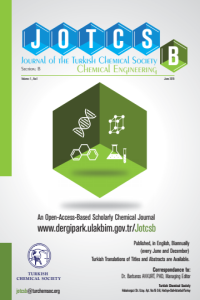INVESTIGATION OF ACQUISITION OF TRIPLE SULFURS FROM Pb(CH3COO)2-Na3AsO4-H2S-H2O SYSTEM BY HYDROCHEMICAL METHOD
Abstract
Acquisition conditions by hydrothermal method of triple sulfides from Pb(CH3COO)2-Na3AsO4-H2S-H2O system were investigated using X-ray phase (X-ray), Differential Thermal (DTA) and Scanning Electron Microscopy (SEM) analysis, TG analysis methods. It was determined that sediments were obtained containing Pb26+xAs12S44+x content in pH=1-6 range and Pb28-xAs12S46-x content (0,6 < x < 1,5) in pH=6-14 range. The durability limits of PbS, As2S5, As2S3, Pb(OH)2, and Na3AsO4 were determined, and pCb-pH (pCb- difference between initial and final concentrations of metal) diagram was formed. The results of the X-ray phase analysis methods indicate that when the precipitates having a Pb:As:S=1:2:4; 2:2:5 and 9:4:15 molar ratio (pH=1-6) are thermally processed in vacuum at 400 °C (~10-2 Pa) in a dual-zone regime, phases containing PbAs2S4, Pb2As2S5 and Pb9As4S15 are conveniently formed. All three compounds are composed of nanoparticles, and high adhesion between particles is observed. Depending on the pH, concentration, and temperature of the condition, a large number of different precipitates and layers are obtained in the Pb(CH3COO)2-Na3AsO4-H2S-H2O system. Based on TG analysis, the stoichiometric composition of PbAs2S4, Pb9As4S15, and Pb2As2S5 compounds was determined.
Keywords
triple sulfur hydrochemical sedimentation semiconductor concentration phase micromorphology
Supporting Institution
Institute of Natural Resources of Nakhchivan Branch of Azerbaijan National Academy of Sciences
Thanks
The study was supported by the Institute of Natural Resources of Nakhchivan Branch of Azerbaijan National Academy of Sciences. The authors are grateful to the organizing committee, head of congress Prof. Dr. Ayfer SARAÇ, Chemical Society of Turkey, Yıldız Technical University for the organizing 31st National Chemistry Congress,with the main theme "starry 100th anniversary of chemistry".
References
- 1. Rzayev B.Z. Arsenin kükürdlü birləşmələri sahəsində yeni tədqiqatlar. Bakı “ELM”, 2002, 95 s.
- 2. Hüseynov Q., İmanov H., Məmmədova S. Natrium-metarsenit və tioasetamid əsasında arsen(V) sulfidin alınması şəraitinin tədqiqi. // NDU “Elmi əsərlər”, 2018, s. 184-188.
- 3. Vinoguradova Gu.Z. Styekloobrazovaniye i fazoviye ravnovyesiya v khalʲkoguyenidnikh sistyemakh. M. : Naooka, 1984. 176 s.
- 4. Loorʲye Yo.Yo. Spravochnik po analitichyeskoy khimii. M.: Khimiya, 1989, 448 s.
- 5. Toolyenin S.S. Guidrokhimichyeskoye osaʐdyeniye plyenok In2S3, In2Se3 i khalʲkopiritnikh strooktoor na ikh osnovye. Diss. k.kh.n., Yekatyerinboorgu, 2015, 197 s.
- 6. Baghbanzadeh M., Carbone L., Cozzoli P.D., Kappe C.O. Microwave-assisted synthesis of colloidal inorganic nanocrystals. // Angew. Chem. Int. Edit. 50, 2011, P. 11312–11359.
- 7. Stiven İ. Boldish and William B. White. Optical bahd gaps of selected ternary sulfide minerals. // American Mineralogist, 1998, Vol. 83, P. 865-871.
- 8. Von B. Ribar und W. Nowacki. Neubestimmung der Kristallstruktur von Gratonit, Pb9As4S15. // Zeitschrift fur Kristallographie, 1969, Bd. 128, P. 321-338.
Abstract
References
- 1. Rzayev B.Z. Arsenin kükürdlü birləşmələri sahəsində yeni tədqiqatlar. Bakı “ELM”, 2002, 95 s.
- 2. Hüseynov Q., İmanov H., Məmmədova S. Natrium-metarsenit və tioasetamid əsasında arsen(V) sulfidin alınması şəraitinin tədqiqi. // NDU “Elmi əsərlər”, 2018, s. 184-188.
- 3. Vinoguradova Gu.Z. Styekloobrazovaniye i fazoviye ravnovyesiya v khalʲkoguyenidnikh sistyemakh. M. : Naooka, 1984. 176 s.
- 4. Loorʲye Yo.Yo. Spravochnik po analitichyeskoy khimii. M.: Khimiya, 1989, 448 s.
- 5. Toolyenin S.S. Guidrokhimichyeskoye osaʐdyeniye plyenok In2S3, In2Se3 i khalʲkopiritnikh strooktoor na ikh osnovye. Diss. k.kh.n., Yekatyerinboorgu, 2015, 197 s.
- 6. Baghbanzadeh M., Carbone L., Cozzoli P.D., Kappe C.O. Microwave-assisted synthesis of colloidal inorganic nanocrystals. // Angew. Chem. Int. Edit. 50, 2011, P. 11312–11359.
- 7. Stiven İ. Boldish and William B. White. Optical bahd gaps of selected ternary sulfide minerals. // American Mineralogist, 1998, Vol. 83, P. 865-871.
- 8. Von B. Ribar und W. Nowacki. Neubestimmung der Kristallstruktur von Gratonit, Pb9As4S15. // Zeitschrift fur Kristallographie, 1969, Bd. 128, P. 321-338.
Details
| Primary Language | English |
|---|---|
| Subjects | Chemical Engineering, Nanotechnology |
| Journal Section | Full-length articles |
| Authors | |
| Publication Date | November 30, 2020 |
| Submission Date | March 2, 2020 |
| Acceptance Date | June 1, 2020 |
| Published in Issue | Year 2020 Volume: 3 Issue: 2 |

This piece of scholarly information is licensed under Creative Commons Atıf-GayriTicari-AynıLisanslaPaylaş 4.0 Uluslararası Lisansı.
J. Turk. Chem. Soc., Sect. B: Chem. Eng. (JOTCSB)


